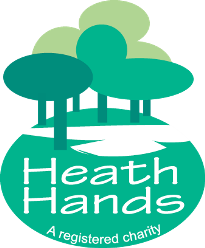What a difference No Mow May makes
In this issue of Field Notes, find out about the benefits of Plantlife’s No Mow May with Assistant Ranger Jo.
If you are lucky enough to have a garden with a lawn, taking part in Plantlife’s ‘No Mow May’ provided the perfect excuse to leave the mower in the shed and let nature do its thing. And what a splendid ‘thing’ nature is. In just four short weeks, a left-alone-lawn will quickly transform into a biodiversity hotspot, festooned with flowers you couldn’t have known were there, and teeming pollen-drunk pollinators humming hypnotic harmonies reminiscent of bygone days.
Nectaring Small Copper butterfly
Azure damselfly takes shelter from the wind and rain amongst the tall grasses in the Old Orchard Garden
Even better, the longer you leave your lawn– or a section thereof – to nature the greater the number of bees, butterflies and other pollinators you will attract. Furthermore, because plants are an essential foundation of all habitats and food webs, you’ll also be providing important habitats for invertebrates, small mammals, birds, reptiles and amphibians.
Thick-legged flower beetle
Longer grass provides shelter and somewhere for animals such this tiny toadlet to forage
Leaving lawns and verges uncut in early summer – and in some instances, throughout the whole of summer – is the kind of sympathetic habitat management practiced on Hampstead Heath. Working in partnership with the City of London Corporation, Heath Hands’ conservation volunteers help to look after much of the Heath’s rich mosaic of habitats, including wildflower meadows and formal garden areas.
One such area is the Old Orchard Garden, which is primarily used for outdoor workshops and as an educational space. For me, this is the most fascinating corner of the Heath because it’s so species-rich. Here, we adopt the ‘mowhican’ method of mowing a single path through the grass once a month, leaving the wildflowers and grasses to grow tall and self-seed. In doing this, ‘short-grass’ plants like daisies, buttercups and clover will flower in profusion on the mown path, and a wider range of nectar-rich plants such as oxeye daisy, knapweed, red campion and vetch can thrive amongst the long grasses.
A Mowhican path at the Old Orchard Garden
Out on the Heath itself, large native wildflower meadows have been created in areas around the Tumulus, Parliament Hill fields and some of the ponds. A lesser-known meadow is the ‘Sparrow Site’, overlooking Heath Hands’ volunteer hub The Hive. This was seeded with native grasses and nectar-rich wildflowers in 2009 as part of a conservation project focusing on house sparrows with the RSPB, and the site is thriving. As well as providing food and shelter for over-wintering invertebrates, it’s a tempting source of food for our target species, the ‘Cockney’ house sparrow, whose numbers have fallen by 60 per cent in UK towns and cities since the mid-1970s.
Parliament Hill wild flower meadow
A volunteer surveys the ‘Sparrow Site’ for pollinators
So the next time you stop to admire the wildflower meadows and the busy proliferation of bees and butterflies on Hampstead Heath, why not consider growing a patch of pollinator paradise in your own back garden or window box? Here are some great ideas to get you started.
If you’d like to help us encourage more house sparrows on to the Heath, and make the most of our beautiful wildflower meadows, you can adopt one of our volunteer-made sparrow boxes here.
You can also support our project to create two new wildflower meadows on Hampstead Heath here.







